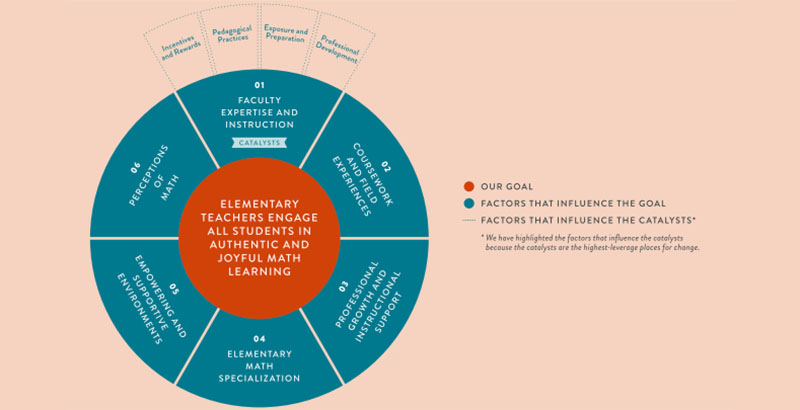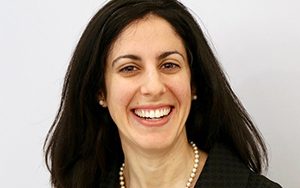Milgrom-Elcott: Better Teacher Preparation in Math Can Break Down Barriers to STEM for Girls, Students of Color & Low-Income Kids

Underrepresentation of girls, students of color and low-income students in science, technology, engineering and math has remained a persistent problem in education — from elementary all the way through graduate school. This gap starts early and has lasting consequences. Students without early exposure to math in the foundational years — namely, pre-K through fifth grade — are more likely to fall behind not just in more-advanced STEM classes but also in their careers. And with careers in STEM among the most lucrative and fastest-growing, this has major implications for the diversity of our workforce, long-term income inequality and the American dream itself.
For too many students, the path to a brighter future is blocked in part by a lack of joyful and authentic math experiences, stigma around math and a belief that success in STEM reflects innate ability rather than engagement and hard work. We know that elementary teachers can help break down these barriers by fostering meaningful and effective math learning. Unfortunately, not enough teachers are prepared and empowered to teach that way, causing too few young students to experience that kind of math instruction. Based on extensive research, 100Kin10 has found that institutions of higher learning are uniquely positioned to remedy this.
Our new report, “Doing the Math,” takes a fresh look at the lingering challenges around foundational math and identifies a half-dozen ways to bridge the disconnect between teacher training and classroom reality, with two powerful opportunities for institutions of higher education. The first is to increase the number of elementary teaching faculty with STEM expertise. The second is to arm subject-matter faculty in universities with knowledge of the active, engaging strategies that future elementary teachers will need to use in their classrooms.
If implemented, the solutions listed in the report — including inviting teachers to serve as guest lecturers in university classes or hosting university faculty in elementary classrooms, and holding workshops for university faculty on math education research-based pedagogy — could solve two problems at once. They would unlock the potential of the millions of pre-K-5 students who have a tough time with math, and they would go a long way toward ending the STEM teacher shortage in the United States by better preparing educators to successfully teach math to younger students. This could help them avoid burnout and stay longer and, flush with a sense of their impact, even encourage friends and students to choose teaching themselves.
These solutions aren’t a silver bullet, but previous research by 100Kin10, with the input of thousands of educators and education experts, produced a long list of potential solutions to the STEM teacher shortage and pinpointed a few key opportunities. Each of these could have domino-like effects on the shortage, potentially ending it once and for all. Among the most powerful solutions are ensuring that pre-service teachers experience the kind of instructional strategies they’ll use in their own classrooms, and that they are prepared with specific STEM skills and strategy.
But despite a pressing need for improvements in math education, many professors have not been exposed to recent advances in what we know about the science of learning. Too few math faculty members have specific training connected to the realities of the classroom. As math instruction changes over time, these faculty members become more distanced from what math instruction looks like in today’s elementary schools.
It’s no secret that faculty are busy with research and scholarship, making it difficult to maintain a focus on teaching, and many universities don’t provide professional development to support faculty’s equally important role as educators of teachers. The result? Even when future educators are trained in the latest and greatest approaches to teaching, they’re not seeing their professors reflect these best practices.
Great universities and alternative prep programs are creating opportunities for professional development to ensure that their professors understand and model effective instruction in math. These promising exemplars have pioneered innovations that are working and can be adapted and improved upon by others:
High Tech High, a network of 16 charter schools serving more than 5,200 K-12 students in San Diego that also prepares teachers for multiple subjects (K-8) and education specialist certification areas, ensures that teacher candidates are learning directly from classroom teachers throughout their training, so they understand how to integrate content knowledge with pedagogy. This setup is intentionally designed around three core pillars to make sure candidates are totally prepared for and confident in the classroom: clear connections between lessons learned in courses and those practiced in classrooms, collaboratively developed coursework, and ongoing participant and instructor feedback and discourse.
TeachingWorks at the University of Michigan has established multiyear, application-based teacher preparation fellowship programs for teacher education faculty from California and Minnesota. The goal of these programs is to introduce teacher educators to key tools in designing and implementing practice-based pedagogies, so they can teach novices fundamental education practices they will need throughout their career. Explicit attention must be paid to making sure that historically marginalized students do not miss out on opportunities for excellent learning because their teachers lack key opportunities for growth.
This work is not just important for new teachers. Experienced elementary teachers also have an important role to play in bridging the divide between training and classroom implementation. Universities can open their doors to elementary teachers with expertise in math instruction to share their insights with students as course instructors and guest lecturers. Faculty can get firsthand experience in elementary math education by visiting classrooms and deepening relationships with local schools. Rider University in New Jersey is an example of a college getting real results from innovations like this. Its College of Education and Human Services has partnered with the university’s math department to develop an intensive course sequence focused on building skills in foundational math instruction. Future teachers in the program learn not just in the university classroom but through real-world experience at nearby schools as well. And faculty from the two departments work together to enhance their own skills as teacher educators.
As STEM becomes even more important to our economy and to our ability to tackle big problems like climate change, disease eradication, income inequality and health disparities, this type of progress can’t come soon enough. Engaging, interactive and early experience with math is critical to putting students and our country on the path to success. And if we want to unleash this generation’s full potential, we have to start with our teachers’ teachers.
Talia Milgrom-Elcott is executive director of 100Kin10.
Get stories like these delivered straight to your inbox. Sign up for The 74 Newsletter

;)
